Strangely, while Drama was challenged for being “sexually explicit,” the story is set in a middle school and has no sex at all in it. Furthermore, Drama has received numerous starred reviews and honors:
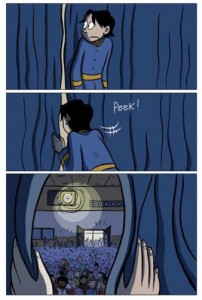 |
| Raina Telgemeier, Drama |
- YALSA named it one of its Top Ten Great Graphic Novels for Teens,
- NPR recommended it as one of the “Five Great Summer Reads for Teens”,
- It was a Publishers Weekly Best Book of 2012,
- A Washington Post Best Book of 2012,
- A New York Times Editors’ Choice; and
- A Booklist Editors’ Choice.
- Drama also received the Stonewall Book Award, and it is a top selling graphic novel in bookstores throughout this country.
The book has a diverse cast of characters, including a few gay teens who either already knew they are gay or are slowly realizing it. That said, Telegemeier treats this as a non-issue, and aside from a few flirty kisses (one of Callie’s lands squarely on her crush’s cheek), there’s little depiction of romantic contact between any characters.
Given this confusion surrounding Drama and its inclusion on ALA’s frequently challenged list, here's a closer look at it in this post. Hopefully this will help teachers, librarians, administrators and parents better understand how to use Drama in their homes, classrooms and libraries. (For a closer look at Persepolis, please read “Using Graphic Novels in Education: Persepolis.”)
OVERVIEW
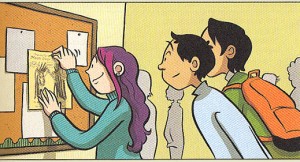 |
| Raina Telgemeier, Drama |
Drama is a funny feel-good book about navigating the trials and tribulations of middle school. It emphasizes the importance of finding one’s voice as well as emphasizing the need for teamwork and consideration. depicts school-girl crushes and travails with humor and sensitivity, relayed through her engaging text, wonderfully expressive characters, and her colorful and engaging visual montages. The art conveys a sense of place, touch, and feel. You can feel the red velvet seats and the pre-show jitters and excitement. You can feel the tension, you can feel the excitement, and you can practically feel the cannon’s wet confetti. Finally, Telgemeier mixes humor, tension, confusion, passion, and fun as she tells Callie’s story.
SUMMARY
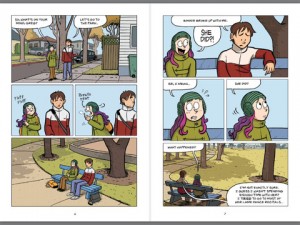 |
| Raina Telgemeier, Drama |
While set up like a play, and following Eucalyptus Middle School’s Drama Club production of “Moon Over Mississippi,” Drama is more about central character Callie and her friends than it is about the play. We follow Callie as she navigates her friendships and school crushes while creating a set worthy of Broadway within her middle school’s paltry budget.
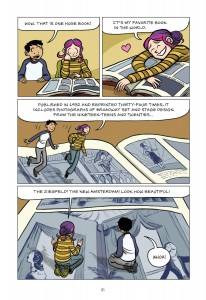 |
| Raina Telgemeier, Drama |
Telgemeier’s art is another special facet of this book. The art and text weave the story, alternating between whether the art or text has the stronger voice, while both are equally engaging. One outstanding example, however, of Telgemeier’s powerful visual storytelling comes as Callie shows Justin her favorite book. In the first few panels, Callie leads Jesse to the book (as Justin checks out some manga). Taking it out of its shelf, Callie hugs it, and in the next panel we see her and Jesse walking into the book, sitting on the pages as if they’re sitting in the sets themselves as the book, at least for Callie, becomes larger than life.
Then there’s Callie herself. Callie’s ability to be so swept away in her passions makes her even more endearing and real. We love her quirkiness, her focus, and her determination as well as her vulnerability and cluelessness about boys. Finally, there’s her inner strength that is so engaging, empowering, and refreshing. Callie speaks her mind, and while often insecure and uncomfortable with certain parts of herself, she’s fine with the fact that she can’t sing, she embraces and follows her ambitions, and she never lets her relationships or felled crushes diminish her confidence or her dreams.
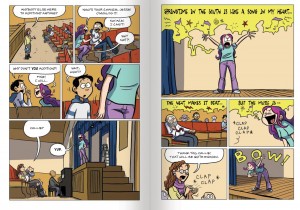 |
| Raina Telgemeier, Drama |
In short, this is a coming-of-age story as a young teenager learns to follow her passions, navigate friendships and crushes, and learns, along with her friends and peers, how to feel comfortable within one’s skin while embrace personal strengths, weaknesses, and quirks.
In Drama, Telgemeier relays:
- How to follow one’s passions and ambitions with gusto and determination, not worrying how it might look;
- How to put on a play from the stage crew’s perspective;
- How to accept people who are different; and
- How to navigate middle school friendships and crushes.
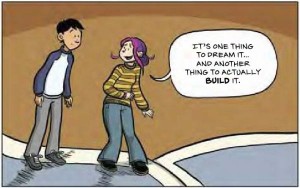 |
| Raina Telgemeier, Drama |
Plot, Themes, and Values Related
- Discuss and chart the different themes Telgemeier presents in this work.
- Discuss different types of friendships one might have with others. Detail what it means to be a good friend. Discuss the challenges we have in determining and maintaining friendships and why this is so important.
- Discuss different passions/hobbies your children/students may have and how they might continue to pursue them. Discuss how it may feel when those passions aren’t “typical” passions/hobbies.
- Discuss the challenges of being an individual while belonging to a group.
- Discuss the challenges of putting on a theatrical production, working within limited budges while trying to create the best sets, props and costumes possible.
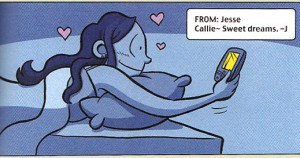 |
| Raina Telgemeier, Drama |
- Telgemeier uses text, image, expressions, body language, and inference to let us know how and what her characters are thinking and feeling. Chart and discuss how she uses and integrates these techniques.
- Throughout the book, we see Matt on the periphery and at one point (p. 62), Callie asks her friend Liz, “What is Matt’s problem?” What is Matt’s problem? Why does he act the way he does, and how might he resolve his problem? Why can’t Callie recognize his problem? What is Matt’s role throughout this story?
- Throughout the book, the characters grapple with insecurities and anxieties. Chart and plot the insecurities and anxieties, and evaluate how the different characters effectively or ineffectively deal with them. Brainstorm more appropriate solutions.
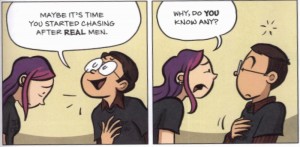 |
| Raina Telgemeier, Drama |
- Discuss how Drama is a cross between a book and a play while being a graphic novel. What literary techniques does Telgemeier use to create this feel?
- After reading through “Moon Over Mississippi,” Callie comments on how romantic the script is and how “audiences love a sentimental love story.” Mirko, not quite sure about this, responds, “But what about Shakespeare? His most successful plays were tragedies?” Continue this discussion with your students. Evaluate what they think makes the most successful plays and how sentimental love stories and Shakespeare’s works fit into students’ interpretations.
- Have students share their own stories of feeling different or their stories of trying to fit in. Compare how the stories are told, and chart the words used to relate their challenges and their feelings.
Modes of Storytelling and Visual Literacy
In graphic novels, images are used to relay messages with and without accompanying text, adding dimension to the story. In Drama, Telgemeier deftly weaves story and background with image, text, and design. Reading Drama with your students allows you to analyze, discuss, and learn how Telgemeier uses page and panels, text, and images to relay complex messages. For example:
- Evaluate how she visually and textually creates the feel of a play.
- Evaluate and discuss how Telgemeier creates the feel of the theatre, of the players, and of the drama surrounding them.
- Evaluate and discuss how Telgemeier uses facial expressions, panel size and shape, and page design to create tension. For example, examine pp. 15-17, as Callie realizes Greg was not at baseball practice as he said he was.
- Compare when Telgemeier uses a full-page single-panel splash versus pages with multiple panels. Chart when she uses single-panel splashes to emphasize key events or separate chapters and slow the reader down to emphasize particular points of the story, and discuss how effective this method is when storytelling with images.
- Telgemeier discusses the importance of color both in the use of contrasting colors to help characters stand out and in creating the right mood. Research primary, additive, and subtractive color models. Discuss how different colors evoke different emotions and how complimentary and reciprocal colors can be used for different purposes (see the resources below).
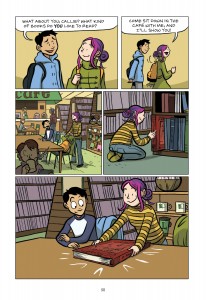 |
| Raina Telgemeier, Drama |
For greater discussion on literary style and content, here are some prose novels about growing up, being a pre-teen/teen, and the challenges of middle school and high school that you may want to read and pair with Drama:
- Smile by Raina Telgemeier — an autobiographical coming-of-age memoir in which Telgemeier ruminates with humor and honesty on the tumultuous challenges and perils of her tween years, from the trauma of falling one night on her way home from a Girl Scout meeting and severely injuring her front teeth to dealing with boys, earthquakes, and the true meaning of friendship.
- The Baby-Sitters Club series by A.M. Martin, illustrated by Telgemeier –- a popular young adult series about teenagers that has been adapted into graphic novel format.
- Diary of a Wimpy Kid by Jeff Kinney — a series about a boy and his struggles in middle school.
- No More Dead Dogs by Gordon Korman — about theater productions gone wrong. The main plot revolves around a play based on Old Shep in which the ending has been changed to let the dog live.
- Nothing Can Possibly Go Wrong by Prudence Shen and Faith Erin Hicks — while for slightly older kids, the characters in this book are a real and life-like as Callie and her friends.
- Hereville by Barry Deutsch — about another strong-willed girl who is Jewish Orthodox and is different from the other girls in her community.
- Chiggers by Hope Larson — a young adult graphic novel about the friendships, fun, and foils of summer camp.
- Amelia Rules! by Jimmy Gownley — an empowering, heart-warming story about Amelia Louise McBride, who moves with her mom to a small town in Pennsylvania to live with her uber-cool aunt Tanner after her parents’ divorce.
- Stuck in the Middle: Seventeen Comics from an UNPLEASANT Age edited by Ariel Schrag — an anthology of comics by critically acclaimed cartoonists who take a bitingly honest look back at their “awkward” middle-school years, reflecting upon them with sensitivity and some humor.
ADDITIONAL RESOURCES:
- https://www.youtube.com/watch?v=ysWrqAMktc0— a YouTube video promotion for Drama
- http://wn.com/raina_telgemeier — a presentation that Telgemeier made at the 2012 National Book Festival about her books and work that demonstrates how she works as she tells her stories, with examples of real-life incidents from an audience of students.
- http://goraina.com — Raina Telgemeier’s website
- http://departingthetext.blogspot.com/2013/01/color-casts-powerful-messages-learn-how.html — a blog post on learning how to use color, with additional links and resources.
- http://char.txa.cornell.edu/language/element/color/color.htm — discussing color, value and hue, along with color illusions and psychological implications of color.
 |
| Raina Telgemeier, Drama |
As always, I thank you for your visit.
Please leave your thoughts, reactions, suggestions in the comments below.
This definitely sounds like a good book, and one that I would have allowed my 2 girls to read when they were teenagers. However, as an educator I know that some parents strongly object to having their children exposed to anything remotely related to gays. When I was Head of a Christian school, I had a couple of parents object to having the Harry Potter series available in the school library, because they felt "it encouraged kids to experiment with witchcraft." I never removed the books from our library's shelves, but did require the students to have a written permission to check them out. It was my job to be the peacemaker. My oldest daughter read the whole series, and at nearly 22 has very strong Christian values.
ReplyDeleteBy the way, Happy ABC Wednesday! #25
ReplyDeletePersepolis? Really? These protests are so...odd.
ReplyDeletePersepolis because of the depiction of torture... Sad.
DeleteI am never surprised at the ignorance of parents. Drama sounds like a quality read, and I will pick up a copy (or more likely sign up for the waiting list) here in Madison, WI, a city known for libraries and a lack of "banned book lists." Harry Potter was on the "sh*t list" (literally, yikes!) in my sister's home when her kids were growing up; similarly, they were not allowed to dress up at Halloween. I tried to explain the idea of Halloween as a fun way for kids to experience just a bit of fear in a safe environment, but she said I was going against Jesus, etc. Of course, she enjoyed Halloween most when we were growing up!
ReplyDeleteThe idea of banning books is so repulsive to me. There is a wonderful Bette Davis film, rarely seen, from the 50s called "Storm Center." I feel so strongly about its worth that I may well write is up for S at ABC in a couple of weeks. All about a library, a troublesome book on Communism, and a librarian with the heart of a lion. Thanks so much for this! Amy
And I'll have to check out "Storm Center."
DeleteThis sounds like a very interesting book. The Babysitter's Club was a fun series to read growing up. I will have to pick up a copy of "Drama" to read it for myself.
ReplyDelete